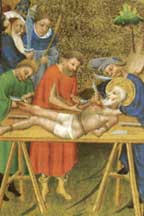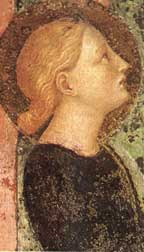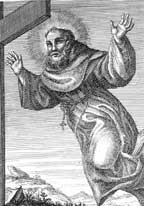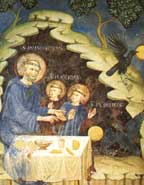
PATRON SAINTS OF SHOEMAKERS
Patron Saints of Shoemakers
Petr HLAVÁCEK
The word patron is used in the majority of European languages and originates from the Latin patronus. Originally, this was the name for the releasing of slaves by their former masters. Veneration of a sanctified person by a certain group of people had already appeared in the period before the first persecution of Christians. During this period, the first Christian communities met in secret places and could visit the graves of their saints only in secret. After the Edict of Milan (313 A.D., when Christianity was raised to the state religion) a transferal of the bodily remains of martyrs to the first chapels occurred where they were placed in special containers into the altars. During the first expansion of Christianity to the north and west of Rome, new bishoprics, abbeys, monasteries and churches were established and reliquaries were sent for them from Rome. The original conditions for sanctification were very loose. It was enough that a saint lived an exemplary life, laid down his life for Christ's teaching to look forward to universal veneration after death. Significant Christian philosophers, teachers and founders of religious communities were also later declared saints. After the tenth century, saints have also been representatives of earthly power, but the conditions for sanctification have become stricter. The process of sanctification lasts several years, universal veneration must be established, miracles demonstrated and his/her bodily remains must be preserved. Equally powerful is universal reverence by believers, which often causes pressure for sanctification "from below". The reasons for veneration of significant saints by certain groups of believers have been very diverse, for example, according to the craft, which the saint performed before death, according to the method of martyrdom, or from a famous episode from the life of the sanctified person etc. Sanctification of some saints as patrons of crafts, towns, territories, kingdoms later expanded. In the literature, the following saints have been uncovered, all of whom were venerated by shoemakers, or cobblers.
St. ANAINUS. All that is known about this saint is that according to the legends, the Apostle Mark healed a certain Anianus of Alexandria, who had been wounded by an awl. After regaining health, Anianus promised his faith to Christ.
St. Apostle BARTHOLOMEW is apparently the oldest patron of shoemakers. He was born in the first century in Galilee and died in the 1st century in Syria. The martyrdom of St. Bartholomew has been documented in abundant legends and in the Middle Ages he was a very revered saint. He is, for example, the patron of the city of Frankfurt am Mainz, Maastricht, but also our Pilsen.
His original name was Nathaniel (Bartholomew appears in the Gospels), which was probably taken from the Hebrew "bar tolmai" or in other words the son of the ploughman's furrow. According to tradition, he was introduced to Christ by the Apostle Philip. In the Gospels of St. John (1, 48) it is said that Christ greeted him with the words, "Here is a true Israelite, in whom there is nothing false." After Christ's death, he preached the Gospels in Armenia, India and Mesopotamia. According to legend, when he healed the daughter of the Armenian king Polimia, she converted to Christianity with her entire family. Polimia's brother, together with pagan princes, had Bartholomew seized and cruelly tortured. In the end, he was condemned to the so-called "Persian death penalty". First he was flayed of his skin and then crucified. He is very often depicted with black, curly hair, sometimes he is shown with a short beard. For example, Michelangelo depicted him in the fresco in the Sistine Chapel. In the Naumberg Cathedral is a famous windowpane with his portrait from the period around the year 1250. This particularly cruel death was apparently the main reason he was later especially venerated by craftsmen, who worked with leather and processed skin.
St. GENGUPLPHUS (Gangolf) A martyr from Varennes in France, originally from a noble family in Burgundy. In his youth he enjoyed hunting and entered into military service. Despite the fact that his wife also came from a noble family, according to the biographical sources, she was immoral and committed shameful debaucheries and therefore Gangolf had to flee. He underwent a difficult training in humility and demonstrated a warm love for the poor when he gave away the greater part of his property and he himself became poor. His wife had relations with a cleric and after it was revealed, she was afraid of being accused of wrong so she had Gangolf assassinated in 760. He is often depicted as a knight with a lance or sword. He is preserved in the fresco cycles of Januaria Zicka in the Church in Amorbach (Franconia) and in the Church of St. Gangolf in Neudanau (Baden).
Ste. CATHERINE OF ALEXANDRIA, according to legend, was the daughter of the Alexandrian king Kosta and was extraordinarily educated and well read. From the beginning she refused all suitors. However, she met with an old hermit, who convinced her to be baptised. When she was called by the Emperor Maximilian (311-313 A.D.) to the celebratory consecration of a pagan temple, she came to the defence of Christianity and was called to recant before the Emperor. He called 50 of the best philosophers, but Catherine proved able to answer all questions and in the end all 50 philosophers themselves were baptised according to legend. This angered the Emperor so much that he had all of them burned and Catherine tortured and starved. In spite of this, however, she always regained her health and finally the Emperor had her beheaded. Today her remains are placed in the Monastery of Ste. Catherine on Mount Sinai. This place played a significant role in the period of the Crusades and in the Middle Ages her veneration spread. Catherine is most often depicted with a crown on her head, with a wheel or a sword. Since the 13th century this saint belonged among the most revered saints immediately after The Virgin Mary. The painting by Lucas Granach the Elder (1506) is famous. Several crafts considered her their patron, but she was also considered the patroness of the Paris University, teachers, speakers, lawyers, as well as tanners and shoemakers.
St. CRISPIN AND CRISPINIAN are without a doubt the most famous patrons of cobblers. They were born in the 3rd century in Rome and died in 287 in Soissons in France. Their names are derived from the Latin "crispus", which denotes curly. Data about them and their lives are known from their trip to France when they travelled with the son of a Roman senator. In the night they earned money as cobblers and always worked for the poor free-of-charge. Because Christianity in this period was persecuted, on the basis of submitted evidence, they were brought before a judge and called to recant their faith and bow before the pagan gods. Upon their refusal, they were covered in oil, thrown into a fire and then drenched with ice water. When a recantation was still not forthcoming, they were quartered, apparently in the year 287. According to another legend, before their deaths their skin was also flayed from their bodies. They are apparently the most widely accepted patrons of shoemakers, tanners and all crafts, which process skin. In Prague, a side altar consecrated in 1714 by shoemakers is located in the T˝n Cathedral, above which hangs a large portrait of both brothers by an unknown artist. The painting is currently undergoing restoration.
St. NEVOLO (NOVELONIUS) was originally a cobbler by profession. He came from France (Amila Province). Until he was 24, he lived a frivolous life. When he fell seriously ill, the help of his patron - St. James, influenced him so much that he gave penance and entered the Tertian order of the Franciscans. He died in 1280 in Faenzi and he is also venerated in this town as the patron of cobblers.
St. THEOBALDUS ROGGERI was trained by shoemakers. He was born in the 11th century in Vico in Italy. He died on 1 June 1150 in Alba. He is revered as the patron of all shoemakers and cobblers in Italy. He selected this profession against the will of his parents, who lived in luxury. He lived through the poor part of his life and when his (economical) wife died, he arranged a pilgrimage throughout Compostelle and spent the remainder of his life as a porter in Alba. There are ballads about him, like when he gave a bag of flour to beggars and then filled it with sand and carried it to a mill, which have been put to verse and preserved as mock charity.
St. BLASIUS of Sebast was a Bishop. He was born in the 3rd century and died in the year 316 in Sebast in Armenia, today Turkey. His biography is surrounded by many legends. According to one of then, he was originally a doctor, according to another a hermit living in the forest with wild animals. During one of the last persecutions of Christians, he had to flee with his followers, but was captured and cruelly tortured. First he was flayed and then quartered. According to legend, in prison he helped save a small boy who had a bone caught in his throat. The Catholic Church to this day grants the so-called "St. Blasius blessing", which is to help illnesses of the throat and pains in the neck. In southern states he is considered the patron of good weather. Apparently, he became the patron of cobblers in connection with the flaying of his skin from his body.
St. ERHARD of Regensburg was also a Bishop. He was born in the 7th century in France. Relatively little is known about his life. According to legend, he healed and baptised Odilia. He was venerated chiefly in Alsace, in Austria and in Lower Bavaria. In Regensburg his name day is celebrated on 19 January. His portrait can be found in the Church of St. Erhard in Styria. Further on the main altar of the small Church Attaching at Freising.
St. EUSEUS was a hermit. He lived in the 4th century in a cliff not far from Serravale (Piedmont), earning a living repairing shoes. More reports about his live have not been preserved.
St. JOSEPH from KOPERTINE was born on 17 July 1603 in Kopertine (Italy) and died 18 September 1663 in Osima. His existence is historically documented. He had a very complicated youth. He was born as a posthumous child. He couldn't go to school and in desperation his mother had him apprenticed to the shoemaking craft. He had to leave it, however. He was apparently physically impaired and the object of laughter from other children. He had, however, a very strong will and was ambitious. Finally, he was accepted with great difficulty into the Conventual order of Franciscans. After 1630 he lived through an extraordinary ecstasy and levitation (flying). Because he continuously gave simple people great attention, he was permanently transferred to an adjacent monastery. He was accused of pretences to saintliness and had to stand before an inquisition. After a long debate, he was finally released. Pope Clement XIII sanctified him in 1767. He is often depicted artistically as ascending, sometimes even with wings. Some portraits can be seen in the museum of the Franciscans in Rome. In 1963 he became the patron of astronauts. American military pilots had already venerated him as their patron during the Second World War.
St. HOMOBONUS (The Good) of Cremona is also historically documented. He was born around the year 1150 in Cremona. He died on 13 November 1197. Already two years after his death he was sanctified by Pope Urban II. It is documented that Homobonus was a great kind soul, he gave gifts to the poor, organised a hospital and looked after orphans. Three years after sanctification, his remains were transferred to a house in Cremona. He is the patron of this violinists' city and is currently venerated by several crafts guilds, drapers, tailors and shoemakers.
Ste. MARY MAGDALENE acquired her second name apparently after the city of Magdala on the western shores of Lake Genezaret, from whence she came. Mary Magdalene is a biblical figure who appears in several places in the Gospels. We know practically nothing about her family status. From the Gospels we know that she accompanied Christ during his crucifixion, took him down from the cross and gave the report about his resurrection. After this only legends follow, according to which, together with her brother Lazar and sister Marta she shared in the spread of Christianity in southern France, from which has developed the tradition of the Magdalene Pilgrimage. Several significant cathedrals and basilisks have been consecrated to her. A series of famous painters have depicted this saint in their works. The reason she was venerated by shoemakers as their patroness is not known.
St. MAURUS, an abbot from Glainfeuil, was born in Rome in the year 510 (or 511) as the son of Senator Eutichius and his wife Julia. He was sent to St. Benedict for his education in his twelfth year. An incident is described in his biography, in which he saved his fraternal brother Placidus from drowning. Maurus pulled him from the river by the hair and walked across the surface of the water without touching the water. After a dispute with Bishop Bertigramus in Le Mans, at the beginning of 543 Maurus left to Gallia together with other monks. In the meantime, a new Bishop, Dumnolus became bishop in Le Mans and St. Maurus could return. He received a confirmation from King Theodobert for the right to establish a monastic order in Glainfeuil, later called the St. Maurus sur Loire Monastery. The monastery was built over a period of eight years and in the year 561 King Theodobert himself visited the monastery. He died on 15 January 584. The remains of this holy monk were exhumed under the supervision of Abbot Odo in the tenth century (apparently the successor to St. Maurus and the author of legends about St. Maurus) and in 868 were temporarily placed in Fosses in the Monastery of St. Peter in Paris. The Reliquary of St. Maura of Glainfeuil, which had been given to the Prague Cathedral by the Emperor Charles IV, was rediscovered in Prague. Saint Maurus of Glainfeuil (sometimes called of Subiak, or of Nursie) has been depicted as a monk with a book and monk's pate, sometimes walking across water. In Belgium he was revered as the patron of shoemakers. Apparently, the oldest known depiction is in the miniature manuscript of a book located in the library of the town of Troyes. His portrait can be found here on the altar painting of the church in R·bÌ.
St. RENE OF SORETA was a bishop. It isn't known when he was born (3rd to 4th centuries). Direct historical data is missing and several historians are of the opinion that this concerns a mixture of facts about two different bishops living and working in the different towns of Soreto and Angers. Their cult of veneration has been documented as early as the 7th century. Since the 13th century, reverence is partially connected with the name of the Bishop Rene of Agres. He is considered as the patron of clog makers.
St. THEOBALD (Dietbald) from Provence was a monk and came from a rich noble family, but he left to Luxembourg to work with his friend as a mason and labourer. Both then undertook a pilgrimage to Rome and Santiago de Compostela. They finally settled at the Camaldule Monastery a Salaniga in Northern Italy. Here, Theobald accepted priestly vestments, but died soon after. Because he was already venerated during his life, he was first preserved in the church in Vicenze, but later his remains were transferred to the abbey in Salanigu. His sanctification occurred in 1073, seven years after his death. He was revered primarily in France, Luxembourg, Belgium, Italy, but also in Austria and Germany. In France, several churches are named after him (St-Thibauld). He is depicted as a pilgrim with a planing tool in a portrait found in the Church of St. Willibrord in Echternach. He is considered the patron of shoemakers, tanners and belt manufacturers.
Conclusion: A relatively large number of saints have been venerated as the patron of shoemakers throughout history and the list submitted here is obviously still incomplete. Even if this overview has been based on several varied sources, it is unusually large and has no equal from any other traditional craft. This study arose as part of another research project. The author has primarily culled from literature and most data is based only on references to legends. It is not possible to consider this as an historical or theological study.
References:
1. SCHAUBER V., SCHINDLER H. M.: Heilige und Namespatrone. Weltbild Verlag GmBH, Augsburg 1993
2. KELLER D., H.: Die Patrone der Heiligen. Verlag-Conto, Ulm 1905
3. BRAUN J.: Tracht und Atribute der Heiligen in der Deutschen Kunst. Geb. Mann Verlag. Berlin.
4. BUCHBERGER M.: Lexikon f¸r Theologie und Kirche. Herder Verlag Freiburg 1935
5. LEGNER A.: Reliquien in Kunst und Kult, Wissenschaftliche Buchgeselschaft Darmstadt
6. FORSTER D.: Die Welt der Christtlichen Symbole, Dritte verbesserte Aufgabe, Innsbruck, Wien, Muenchen
7. BRAUN J: Die Reliquiqre des christlichen Kultes und Ihre Entwicklung. HERDER und CO GMBH, Verlagsbuchhandlung, Freiburg im Breisgau 1940
8. ACTA SANCTORUM, Antverpiae, MDCCXXXIX
9. ATTWATER D: The Penguin Dictionary of Saints, Harmondsworth 1970
10. FARMER D. H.: The Oxford Dictionary of Saints, Oxford 1980
Petr HLAVÁCEK











